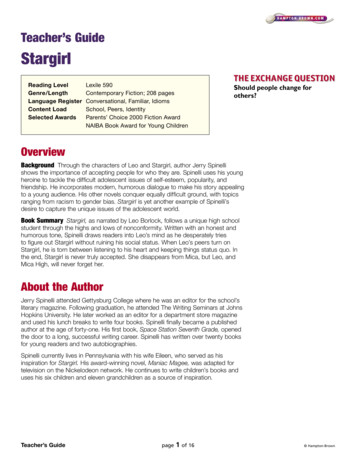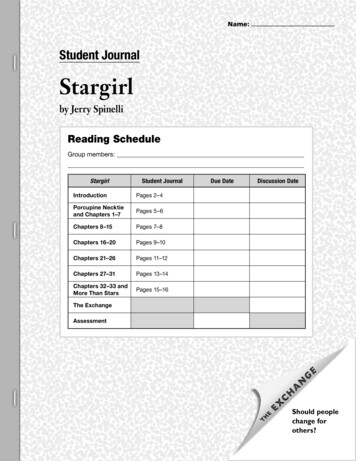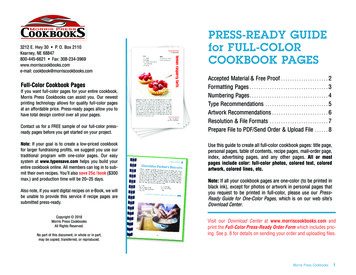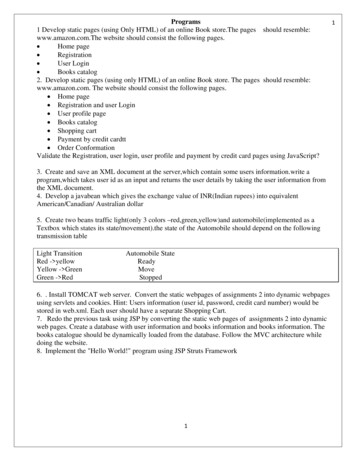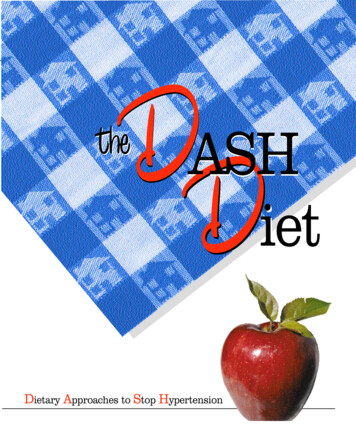
Transcription
DASHietDtheDietary Approaches to Stop Hypertension
The Dash DietThe DASH (Dietary Approaches to Stop Hypertension) was a research studytesting how what we eat effects our blood pressure. A diet reduced in total andsaturated fat and rich in fruits, vegetables, and low-fat dairy foods was found to significantly lowerblood pressure. In participants who had high blood pressure, the DASH diet lowered blood pressureto the same extent as does an blood pressure medicine. The DASH diet can offer an important wayto prevent and treat high blood pressure.Note: If you have high blood pressure and are currently taking blood pressure medicine, do notstop your medicines and start the diet. Talk with your doctor before you stop taking your medicine.The purpose of this brochure is to provide information about the DASH diet and how to follow it athome. The DASH eating plan shown below is based on 2,000 calories a day. Depending on yourcaloric needs, your number of daily servings in a food group may vary from those listed. Thiseating plan from the "Dietary Approaches to Stop Hypertension" (DASH) study is rich in fruits,vegetables, and low fat dairy foods, and low in saturated and total fat.Tips on Eating the DASH Way Start small. Make gradual changes in your eating habits. Center your meal around carbohydrates such as pasta, rice, beans or vegetables instead of meat. Treat meats are a part of the whole meal instead of the main course. Use fruits or low fat, low-caloried foods for desserts or snacksMake the most of the DASH diet!If you use the DASH diet to help prevent or control high blood pressure, make it a part of a lifestylethat includes: choosing foods lower in salt and sodium keeping a healthy weight being physically active, and, if you drink alcohol, doing so in moderation.Make It WorkChange your eating habits graduallyMost people find it hard to make changes in their diet if they try to do too muchtoo fast. Start slow. You are more likely to have your healthier habits be lasting onesif you make small changes that you can realistically maintain. Try some of these steps: If you eat only one or two vegetables a day, add one serving at lunch and one at dinner. If you don't eat fruit or only have juice at breakfast, add fruit as a snack. Use half the butter, margarine, or salad dressing you usually have now. Try low fat or nonfat condiments, like nonfat salad dressings. Drink low fat (1%) or skim milk with lunch or dinner instead of soda, alcohol, orsugar-sweetened tea. Treat meat as one part of the whole meal, instead of the focus Although meat contains protein and other nutrients which are good for your body, it also has a lotof fat, including saturated fat, calories, and cholesterol. Often people have a large portion of meat asa main course and don't eat enough vegetables or grains. To help change your diet, try some of thefollowing tips: Limit meat to six ounces a day (2 servings), which is all you need to be healthy. That is less thanmost people eat. Three to four ounces is about the same size as a deck of cards. If you currently eat large portions of meat, cut back by half or by one-third at each meal. Include two or more meatless meals every week. Include more servings of vegetables, rice, pasta and beans so that you need less meat to make as a t i s fying meal. Casseroles, pasta and stirfry often include less meat and more vegetables, grainsand beans. Buy less meat. If it's not there, you won't eat it.What can you do if you get off track? Don't let a few days of an un-DASHing diet de-rail your health goals. When you find that you are notDASHing your way to good health, there are several helpful steps to take to get yourself Step back and take a look. What happened? Was there a specific event that distracted you from yourDASH health goals (like a holiday or a party or a problem at work or home?). Now is the time to usethis as a learning experience and begin again. Don't beat up on yourself. Everyone makes mistakes and it's all a part of learning new ways to behealthier. Remember that changing your lifestyle is a long-term process. Were you trying to do too much at once? This happens to many people as they start to make lifestylechanges. Try to change only one or two things at a time to keep it manageable. Break it down into small steps. Remember the wise saying to "keep it simple". This is true withlifestyle change as well. Break complex goals down into small, simple, attainable ones. Keep a food diary. You can easily see what is happening with your diet when it is written down inblack and white. Keeping a diet log can help you identify the problem by seeing your patterns ofbehavior more clearly. Write down what you eat for a few days and note where you are and what youare doing and feeling at the time. Many people eat in front of the TV (and then feel like they haven'teven eaten at all) or eat to relieve stress. Keeping a diary can help you make sure you are getting inyour goal amount of fruits and vegetables. Recognize and celebrate your success. Success often comes in small steps. Remember to acknowledge and celebrate your health accomplishments each step along the way.
DashDiet Food Choices and Servings SizesTo help you follow the DASH diet, listed below are the suggests the number ofservings per day from each of the food groups. These servings apply to people who require 2000calories per day. The number of servings you need may be more or less depending on your age,sex, body size, and how active you are. Talk with your doctor or a dietitian to find out your caloricneeds. Check here to see suggested number of servings for other calorie levels. The following areexamples of food choices for each food group.7-8 servings Grains and Grain Products per dayGrains and grain products, which include breads and cereals, are important sources of energy, fiberand vitamins. Choose whole grains, such as whole wheat bread and whole grain cereals to obtainmost of the nutrients. Prepare grain products with small amounts (if any) of fat and sugar.Food ChoicesBagelBarley, cookedBiscuit, country styleBread, whole wheat, whiteCereals, cold, such as bran flakes, shredded wheatCereals, cooked, such as oatmeal, gritsCornbreadCrackers, grahamCrackers, saltineDinner roll, white or wheatEnglish muffinHamburger bunMuffinPancakePasta, spaghetti, macaroni or noodlesPita, white or whole wheatPopcornPretzelsRice, white, brown, or wildTortillas, corn or flourWaffleWheat germOne Serving Equals1/2 medium1/2 C1 medium1 slice1/2 C1/2 C1 medium241 medium1/21/21 medium1 medium1/2 C cooked1/2 large, or 1 small1 C popped1 oz1/2 C cooked1 medium1 medium1/4 C4-5 servings Vegetables per dayVegetables are rich sources of potassium, magnesium and fiber. Keep in mind that foods eatenin smaller portions, for example 1/4 cup of raw carrots, still count as part of the vegetable servings,but would only counts as one half of a serving.1/2 cup of the following cooked vegetables equals 1 serving:AsparagusBeans (green, yellow)BeetsBroccoliBrussels SproutsCarrotsCauliflowerCollard, chicory, mustard,turnip, and other greensCornKa l eLima beansMixed vegetablesOkraParsnipsPotatoes (1/2 medium or1/2 C mashed)PumpkinRutabagaSpaghetti or tomato sauceSpinachSquash (Zucchini or yellow)Stewed tomatoesSuccotashSweet potatoesTurnipsYamRaw vegetables:1/2 C carrots1/2 C chopped celery1/2 C chopped peppers1 C lettuce (romaine,looseleaf, greenleaf)1 C spinach1/2 tomato4-5 servings Fruits per dayFruits and fruit juices are important sources of potassium, magnesium and fiber and are naturally lowin sodium and fat. Fresh, frozen, canned and dried fruits can all be used. The amounts in parenthesesequal one serving.Fresh fruits:Apple (1 medium)Apricots (2 medium)Banana (1 medium)Berries (1/2 c)Melon (1 wedge, or 1/2 c)Cherries (10 each)Grapefruit (1/2 each)Grapes (15 medium)Kiwi (1 medium)Mango (1/2 small)Nectarine (1 medium)Oranges (1 medium)Peach (1 medium)Pear (1 medium)Pineapple (1/8 medium, or 1/2 cup)Plums (2 medium)Tangerine (1 large)Juices (3/4 cup, or 6 oz)Apple juice or ciderCranberry juiceGrape juiceGrapefruit juiceMixed fruits juiceNectarOrange juicePineapple juicePrune juiceCanned/Frozen Fruits (1/2 cup):ApplesauceApricotsBerriesCherriesFruit salad or cocktailGrapefruit sectionsMandarin orangesMelon ballsOrange sectionsPeachesPearsPineappleDried fruits (1/4 cup):ApricotsCranberriesCurrantsDatesFigsMixed dried fruitsPeachesPrunesRaisins
2-3 servings Low fat or Nonfat Dairy Foods per dayDairy foods are major sources of protein and calcium. It is important to select low fat or nonfat dairyproducts to lower your the amount of fat you eat each day. Amounts in parentheses equal one serving.Food Choices1% low fat milk2% low fat milkLow fat, and nonfat yogurt, fruit flavored or plainLow fat cheddar cheeseLow fat Cottage cheeseLow fat or nonfat frozen yogurtMozzarella cheese, part skimNonfat dry milk powderOther low fat or nonfat cheesesParmesan cheeseRicotta cheese, part skim milk or nonfatSkim milk2 or fewer servings of Meats, Poultry and Fish per dayOne Serving Equals1 C or 8 fl. oz1 C or 8 fl. oz1 C or 8 oz1.5 oz1C1/2 C or 4 fl. oz1/4 C or 1 oz1/3 C1.5 oz1 Tbsp1/4 C or 1.5 oz1 C or 8 fl. oz4-5 servings Nuts, Seeds and Legumes per week(more legumes and fewer nuts servings)AlmondsBeans such as kidney, pinto, and navyChickpeas and lentilsCashewsFilbertsMixed nutsPeanut butterPeanutsSesame seedsSunflower seedsTofu, regularWalnutsMeat, poultry an fish are good sources of high quality protein and magnesium.Meats should be baked or broiled, not fried. A 3 ounce portion is about the size of adeck of playing cards.Food ChoicesFish and shellfishLean meat including beef, veal, or porkLow fat luncheon meatsMeat alternatives such as eggs (1 medium) or tofuSkinless, white meat poultry including turkey, chickenOne Serving Equals1/3 C1/2 C cooked1/2 C cooked1/3 C1/3 C1/3 C2 Tbsp1/3 C2 Tbsp2 Tbsp3 oz1/3 COne Serving Equals3 oz cooked3 oz cooked1 oz3 oz3 oz cookedFatsThe DASH diet included plenty of whole grains, fruits, vegetables and low fat dairy products, it waslimited in fat, sweets, and salt. The DASH diet has 27% of its calories as fat. The fat in this diet waspresent both in foods (meats, dairy and grains and mixed dish recipes) and added to foods (approximately 2.5 servings per day of added fats, oils, and salad dressing). To maintain fat intake at roughlythe same level as the DASH diet, do not exceed 2-3 daily servings added fat such as margarine or mayonnaise. Amounts in parentheses are equals one serving.Food ChoicesNuts, seeds and legumes are rich sources of energy, magnesium, potassium, protein and fiber. Nutsand seeds are also high in fat, so portions should be small. The amount for in the parenthesis equalsone serving.Food ChoicesMeats Poultry & Fishsoft margarine or butterregular mayonnaiselow fat mayonnaisesalad dressinglight salad dressingoil (olive, corn, canola, safflower or other vegetable oils)One Serving Equals1 teaspoon1 teaspoon1 Tbsp1 Tbsp2 Tbsp1 teaspoonSweetsThe DASH diet contained, on average, less than one serving daily of sweets or about 5servings per week. Because this diet was lower in fat, most of the sweets were low in fat.Food Choiceshard candiesjelly or jamJellojelly beanslow fat or nonfat frozen yogurtmaple syruppopsiclesherbetsugarsugared lemonade or fruit punchOne Serving Equals3 pieces1 Tbsp1/2 C1/2 oz1/2 C1 Tbsp11/2 C1 Tbsp8 fl. ozTo satisfy a desire for sweets, we recommend trying diet fruit flavored gelatin, or frozen,canned or fresh fruit for dessert.
DashDietQuick Reference Table!The DASH diet, based on a 2000 calorie diet. It contains the number of servings from each of thefood groups shown in the table. Depending on your caloric needs, the number of servings may vary.Food GroupDaily ServingsGrains andgrain products7-81 slice bread1/2 C dry cereal1/2 C cooked rice,pasta or cerealwhole wheat breads,English muffin, pita bread,bagel, cereals and fiber,grits, oatmealVegetables4-51 C raw leafyvegetable1/2 C cookedvegetable6 oz vegetable juicetomatoes, potatoes, carrots,peas, squash, broccoli,turnip greens, collards,kale, spinach, artichokes,beans, sweet potatoesFruits4-56 oz fruit juice1 medium fruit1/4 C dried fruit1/2 C fresh, frozen,or canned fruitapricots, bananas, dates,grapes, oranges, orangejuice, grapefruit, grapefruitjuice, mangoes, melons,peaches, pineapples,prunes, raisins,strawberries, tangerinesLow fator nonfatdairy foods2-38 oz milk1 C yogurt1.5 oz cheeseskim or 1 % milk, skim orlow fat buttermilk, nonfator low fat yogurt, partskim mozzarella cheese,nonfat cheese3 oz cooked meats,poultry, or fishselect only lean; trim awayvisible fats; broil, roast, orboil, instead of frying;remove skin from poultry1/21.5 oz or 1/3 C2 Tbsp seeds1/2 C cooked legumesalmonds, filberts, mixednuts, peanuts, walnuts,sunflower seeds, kidneybeans, lentilsMeats,poultry,fishNutsC cup2 or less1/2Tbsp tablespoon1 Serving Equalsoz ounceFood Choices
A diet reduced in total and saturated fat and rich in fruits, vegetables, and low-fat dairy foods was found to significantly lower blood pressure. In participants who had high blood pressure, the DASH diet lowered blood pressure to the same extent as does an blood pressure medicine. The DASH diet can offer an important way

